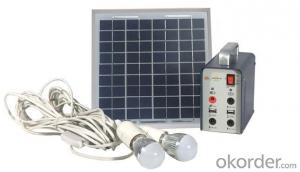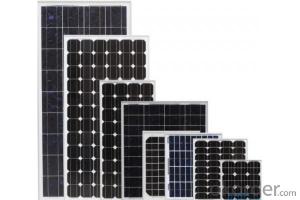25w Small Solar Panels with Good Quality for Solar Energy Systems in California
- Loading Port:
- China main port
- Payment Terms:
- TT OR LC
- Min Order Qty:
- 1 watt
- Supply Capability:
- 10000000 watt/month
OKorder Service Pledge
OKorder Financial Service
You Might Also Like
Specification
Product Description:
Hot Sale !!! Quality and Safety of Small Poly Solar Panel 35~85w
1. Rigorous quality control meets the highest international standards.
2. High-transmissivity low-iron tempered glass, strong aluminium frame.
3. Using UV-resistant silicon.
4. IS09001/14001/CE/TUV/UL
Warranties of Small Poly Solar Panel 35~85w
1. 10 years limited product warranty
2. 15 years at 90% of the minimal rated power output
3. 25 years at 80% of the minimal rated power output
Specification
Characteristics of Poly solar panels CNBM (245-320W) | |||||
Max Power Voltage Vmp(V) | 30.3 | 30.8 | 31.1 | 31.4 | 31.85 |
Max Power Current Imp(A) | 7.60 | 7.64 | 7.73 | 7.81 | 7.85 |
Open Circuit Voltage Voc(V) | 36.1 | 36.6 | 37 | 37.3 | 37.68 |
Short Circuit Current Isc(A) | 8.50 | 8.55 | 8.65 | 8.75 | 8.85 |
Max Power Pm(W) | 230W | 235W | 240W | 245W | 250W |
Temperature Coefficient of Cells Poly solar panels CNBM (245-320W) | |
NOCT | 45± 2 |
Temperature Coeffucients of Isc | 0.0492 |
Temperature Coeffucients of Voc | -0.3374 |
Temperature Coeffucients of Voc | -0.4677 |
Mechanical Data of Poly solar panels CNBM (245-320W) | |
Dimension | 1638 × 982 × 40 mm |
Weight | 19.5 kg |
No. of Cells and Connections | 60 (6 ×10) |
Tolerance | 0 ~ + 5 W |
Cell | Monocrystalline Cell 156 × 156 mm |
Packing | 624 Pcs/40ft(H) Container |
Limits of Poly solar panels CNBM (245-320W) | |
Operating Temperature | -40 to +85 |
Storage Temperature | -40 to +85 |
Max System Voltage | 1000VDC(IEC) / 600VDC(UL) |
Features of our products:
• High conversion efficiency mono/poly-crystalline amorphous silicon solar cells
• Modules incorporate high performance bypass diodes to minimize the power drop caused by shading
• High transmittance, low-iron tempered glass
• High performance EVA encapsulant to prevent destroying and water.
• AI frame: without screw, corner connection. 8 holes on the frame can be installed easily
• Good performance of preventing from atrocious weather such as wind and hails
• Certifications: CE IEC TUV VDE UL, Class I
• 10 years 90% power output warranty

Shipping of Small Poly Solar Panel 35~85w
By Sea | Delivery from Shanghai or Ningbo seaport |
By Air | Departure from Shanghai Pudong Airport |
By Express | Post by DHL, EMS, UPS, TNT. |
- Q: How do solar energy systems impact energy storage technologies?
- Solar energy systems have a significant impact on energy storage technologies by providing a clean and renewable source of electricity. These systems generate electricity during the day when the sun is shining, but often produce more energy than needed. Energy storage technologies allow excess energy to be stored and used during periods of low or no solar generation, ensuring a constant and reliable power supply. This integration of solar energy systems with energy storage technologies promotes grid stability, reduces reliance on fossil fuels, and accelerates the transition towards a sustainable energy future.
- Q: Can a solar energy system be used in areas prone to hurricanes or tornadoes?
- Yes, a solar energy system can be used in areas prone to hurricanes or tornadoes. While it is true that these natural disasters can cause damage to solar panels and other components of the system, proper planning and installation can mitigate the risks. One key consideration is the design and structural integrity of the solar panels themselves. High-quality solar panels are built to withstand strong winds and extreme weather conditions. They are usually tested and certified to meet specific standards, including wind resistance ratings. In areas prone to hurricanes or tornadoes, it is important to install solar panels that are specifically designed to withstand the potential wind speeds and impacts associated with these events. Additionally, proper installation techniques can enhance the resilience of a solar energy system. For example, using reinforced mounting structures, securing panels with additional brackets or fasteners, and ensuring secure connections between panels, inverters, and batteries can help prevent damage caused by strong winds or flying debris. In some cases, homeowners may also choose to invest in solar panel tracking systems that allow the panels to automatically adjust their position to reduce wind resistance during extreme weather events. This feature can help protect the panels and increase their chances of surviving a hurricane or tornado with minimal damage. Furthermore, it is essential to have a backup power storage system in place, such as batteries, to ensure continuous power supply during and after a severe weather event. This backup system can store excess energy generated by the solar panels, allowing the system to operate independently of the grid during power outages caused by hurricanes or tornadoes. Overall, while there are risks associated with using a solar energy system in areas prone to hurricanes or tornadoes, careful planning, proper installation, and the use of resilient components can make it possible to harness solar power even in these challenging environments.
- Q: Are there any tax credits available for installing a solar energy system?
- Yes, there are tax credits available for installing a solar energy system. The federal government offers a Solar Investment Tax Credit (ITC) that allows homeowners and businesses to deduct a percentage of the system's cost from their taxes. Additionally, some states and local governments may also offer their own tax incentives for solar installations.
- Q: What are the different applications of solar energy systems in transportation?
- Transportation can benefit greatly from the utilization of solar energy systems in various ways. By incorporating solar panels onto vehicles such as electric cars, carbon emissions and reliance on fossil fuels can be reduced. This not only extends the driving range of electric vehicles but also lessens the need for charging from the electrical grid. Furthermore, solar energy can be harnessed in charging stations specifically designed for electric vehicles. These stations can be equipped with solar panels, allowing them to generate clean electricity for charging purposes. This shift away from non-renewable energy sources contributes to the establishment of a more sustainable transportation system. Another avenue for solar energy systems in transportation is seen in public transportation. By implementing solar-powered buses and trains, cities can offer emission-free transportation options, thereby decreasing air pollution and enhancing air quality. Solar panels installed on the roofs of these vehicles can additionally power various onboard systems, including lighting, air conditioning, and information displays, further minimizing energy consumption. In addition to electric vehicles and public transportation, solar energy systems can also be integrated into other modes of transportation like bicycles and boats. By incorporating solar panels into the design of these vehicles, electricity can be generated to power electric motors or charge batteries. This advancement makes these transportation options more energy-efficient and environmentally friendly. In summary, the applications of solar energy systems in transportation are vast and hold immense potential for reducing greenhouse gas emissions while simultaneously promoting sustainable transportation options. By harnessing the power of the sun, we can create a future for transportation that is cleaner and more environmentally friendly.
- Q: How do solar energy systems impact grid stability?
- Solar energy systems can have both positive and negative impacts on grid stability. On one hand, solar power can help enhance grid stability by reducing the strain on traditional power plants and diversifying the energy mix. Solar energy is typically generated during the day when demand is high, which can help meet peak demand and stabilize the grid. On the other hand, the intermittent nature of solar power can present challenges to grid stability, as it is dependent on weather conditions. This intermittency can lead to fluctuations in power generation, which may require additional grid management strategies and energy storage solutions to ensure stability.
- Q: Can solar energy systems be used in powering wineries or breweries?
- Yes, solar energy systems can be used to power wineries or breweries. Solar panels can be installed on the roofs of the buildings or in nearby open areas to generate clean and renewable electricity. This can help wineries and breweries reduce their dependence on fossil fuels, lower their energy costs, and contribute to a more sustainable and environmentally-friendly operation.
- Q: Are there any risks of electrical shocks during installation or maintenance of solar energy systems?
- Yes, there are risks of electrical shocks during the installation or maintenance of solar energy systems. These risks can occur due to the high voltage of the system, improper grounding, faulty wiring, or inadequate safety precautions. It is crucial to follow proper safety procedures, use appropriate personal protective equipment, and ensure that qualified professionals handle the installation and maintenance to minimize the risk of electrical shocks.
- Q: Can a solar energy system be installed in areas with high seismic activity?
- Yes, a solar energy system can be installed in areas with high seismic activity. However, it is important to ensure that the system is designed and installed in a way that can withstand the potential impact of earthquakes. This may involve using specialized mounting systems, reinforcing structures, and conducting thorough assessments of the site's geological conditions. By following proper engineering practices and regulations, solar energy systems can be safely installed and operated in seismic-prone areas.
- Q: Can solar energy systems be used in powering government buildings or offices?
- Yes, solar energy systems can be used to power government buildings or offices. In fact, many government buildings around the world have already adopted solar energy systems as a means of reducing their carbon footprint and dependence on traditional energy sources. Solar panels can be installed on rooftops or in open spaces adjacent to government buildings, harnessing sunlight to generate electricity that can be used to power various activities within the buildings. This sustainable approach not only helps in reducing greenhouse gas emissions but also saves money on energy bills in the long run.
- Q: How long does it take for a solar energy system to pay for itself?
- The time it takes for a solar energy system to pay for itself, also known as the payback period, depends on various factors such as the initial cost of the system, energy usage, location, and available incentives. On average, residential solar systems have a payback period of around 6 to 10 years. However, with decreasing installation costs and increasing energy prices, this timeframe is continually reducing, making solar energy an increasingly attractive investment.
Send your message to us
25w Small Solar Panels with Good Quality for Solar Energy Systems in California
- Loading Port:
- China main port
- Payment Terms:
- TT OR LC
- Min Order Qty:
- 1 watt
- Supply Capability:
- 10000000 watt/month
OKorder Service Pledge
OKorder Financial Service
Similar products
Hot products
Hot Searches
Related keywords






























